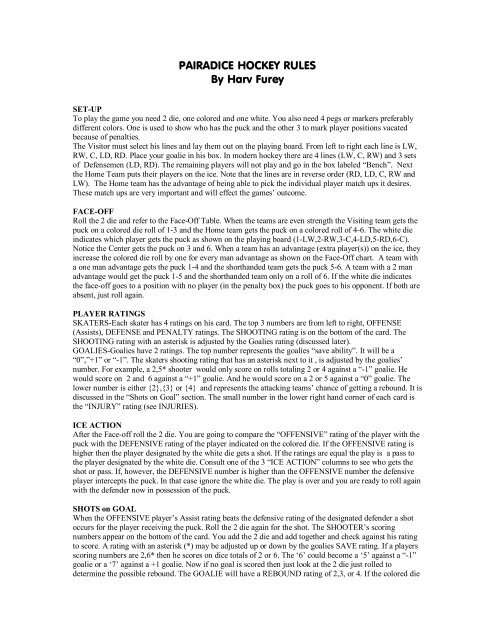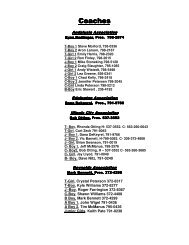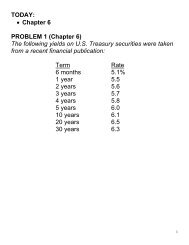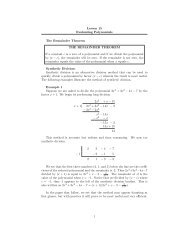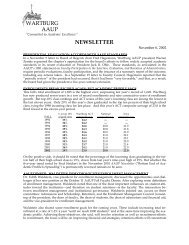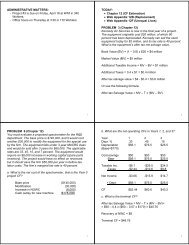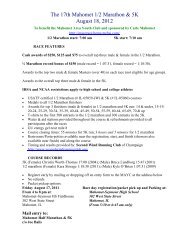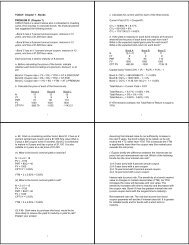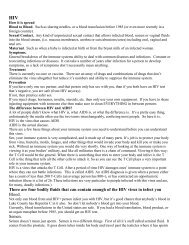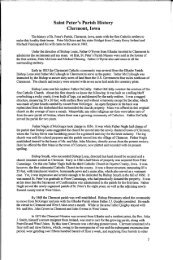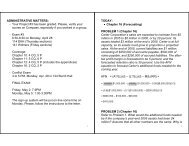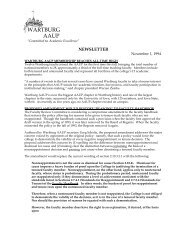PAIRADICE HOCKEY RULES By Harv Furey
PAIRADICE HOCKEY RULES By Harv Furey
PAIRADICE HOCKEY RULES By Harv Furey
You also want an ePaper? Increase the reach of your titles
YUMPU automatically turns print PDFs into web optimized ePapers that Google loves.
<strong>PAIRADICE</strong> <strong>HOCKEY</strong> <strong>RULES</strong><br />
<strong>By</strong> <strong>Harv</strong> <strong>Furey</strong><br />
SET-UP<br />
To play the game you need 2 die, one colored and one white. You also need 4 pegs or markers preferably<br />
different colors. One is used to show who has the puck and the other 3 to mark player positions vacated<br />
because of penalties.<br />
The Visitor must select his lines and lay them out on the playing board. From left to right each line is LW,<br />
RW, C, LD, RD. Place your goalie in his box. In modern hockey there are 4 lines (LW, C, RW) and 3 sets<br />
of Defensemen (LD, RD). The remaining players will not play and go in the box labeled “Bench”. Next<br />
the Home Team puts their players on the ice. Note that the lines are in reverse order (RD, LD, C, RW and<br />
LW). The Home team has the advantage of being able to pick the individual player match ups it desires.<br />
These match ups are very important and will effect the games’ outcome.<br />
FACE-OFF<br />
Roll the 2 die and refer to the Face-Off Table. When the teams are even strength the Visiting team gets the<br />
puck on a colored die roll of 1-3 and the Home team gets the puck on a colored roll of 4-6. The white die<br />
indicates which player gets the puck as shown on the playing board (1-LW,2-RW,3-C,4-LD,5-RD,6-C).<br />
Notice the Center gets the puck on 3 and 6. When a team has an advantage (extra player(s)) on the ice, they<br />
increase the colored die roll by one for every man advantage as shown on the Face-Off chart. A team with<br />
a one man advantage gets the puck 1-4 and the shorthanded team gets the puck 5-6. A team with a 2 man<br />
advantage would get the puck 1-5 and the shorthanded team only on a roll of 6. If the white die indicates<br />
the face-off goes to a position with no player (in the penalty box) the puck goes to his opponent. If both are<br />
absent, just roll again.<br />
PLAYER RATINGS<br />
SKATERS-Each skater has 4 ratings on his card. The top 3 numbers are from left to right, OFFENSE<br />
(Assists), DEFENSE and PENALTY ratings. The SHOOTING rating is on the bottom of the card. The<br />
SHOOTING rating with an asterisk is adjusted by the Goalies rating (discussed later).<br />
GOALIES-Goalies have 2 ratings. The top number represents the goalies “save ability”. It will be a<br />
“0”,”+1” or “-1”. The skaters shooting rating that has an asterisk next to it , is adjusted by the goalies’<br />
number. For example, a 2,5* shooter would only score on rolls totaling 2 or 4 against a “-1” goalie. He<br />
would score on 2 and 6 against a “+1” goalie. And he would score on a 2 or 5 against a “0” goalie. The<br />
lower number is either {2},{3} or {4} and represents the attacking teams’ chance of getting a rebound. It is<br />
discussed in the “Shots on Goal” section. The small number in the lower right hand corner of each card is<br />
the “INJURY” rating (see INJURIES).<br />
ICE ACTION<br />
After the Face-off roll the 2 die. You are going to compare the “OFFENSIVE” rating of the player with the<br />
puck with the DEFENSIVE rating of the player indicated on the colored die. If the OFFENSIVE rating is<br />
higher then the player designated by the white die gets a shot. If the ratings are equal the play is a pass to<br />
the player designated by the white die. Consult one of the 3 “ICE ACTION” columns to see who gets the<br />
shot or pass. If, however, the DEFENSIVE number is higher than the OFFENSIVE number the defensive<br />
player intercepts the puck. In that case ignore the white die. The play is over and you are ready to roll again<br />
with the defender now in possession of the puck.<br />
SHOTS on GOAL<br />
When the OFFENSIVE player’s Assist rating beats the defensive rating of the designated defender a shot<br />
occurs for the player receiving the puck. Roll the 2 die again for the shot. The SHOOTER’s scoring<br />
numbers appear on the bottom of the card. You add the 2 die and add together and check against his rating<br />
to score. A rating with an asterisk (*) may be adjusted up or down by the goalies SAVE rating. If a players<br />
scoring numbers are 2,6* then he scores on dice totals of 2 or 6. The ‘6’ could become a ‘5’ against a “-1”<br />
goalie or a ‘7’ against a +1 goalie. Now if no goal is scored then just look at the 2 die just rolled to<br />
determine the possible rebound. The GOALIE will have a REBOUND rating of 2,3, or 4. If the colored die
2<br />
is equal to or less than the Goalies REBOUND rating then the OFFENSE gets the rebound and as shown on<br />
the chart goes to one of the 3 forwards. Defensemen do not get offensive rebounds. If the colored die<br />
exceeds the goalies REBOUND rating then the DEFENSE gets the rebound as shown on the REBOUND<br />
Chart. A white ‘6’ on a defensive rebound is a “PUCK FROZEN”. Make a line change and go to a face-off.<br />
A lot of players, mostly defensemen, have low shooting percentages. Many have a 2* rating. When a 2*<br />
rated player shoots against a goalie with a “-1” rating and you roll a ‘2’ you must roll the dice again. If you<br />
roll doubles (i.e. 11,22,33,44,55,66) on that roll he scores. Otherwise use the dice roll as normal to<br />
determine the rebound result.<br />
TIMING the GAME<br />
Whenever a white ‘6’ is rolled on a dice roll in the “ICE ACTION” play sequence or when a shot is taken,2<br />
minutes have elapsed. Ten white ‘6’s equal one period. DO NOT count white 6’s on face -offs. On your<br />
scoresheet, mark a stroke for each white 6. After a white 6 the puck goes to the player on the next line. If a<br />
shot is involved the original line’s player takes the shot. If a rebound is involved it goes to the player on the<br />
next line. If you play a 5 minute overtime then 3 white ‘6’s constitute an overtime period.<br />
LINE CHANGES<br />
Change lines after every play stoppage (i.e. a goal, penalty, face off ) or when you roll a white’6’. You<br />
must go to the next line when you roll a white’6’. If a player has a “ ^ “ symbol next to his OFFENSIVE<br />
(ASSIST) rating or his DEFENSIVE rating he is permitted to “double shift” or play on 2 consecutive lines.<br />
Normally this is done on Power plays or penalty killing lines. A few players have 2 “ ^ “ and may be triple<br />
shifted. The double shift need not be a penalty situation but normally will be used this way. In modern day<br />
hockey teams use 4 sets of forwards and 3 sets of defensemen. So when your 4 th line takes the ice you must<br />
alternate which pair of defensemen will play.<br />
POWER PLAY <strong>RULES</strong> & 4 on 4<br />
When one team has a one or two man advantage or the two teams are playing 4 on 4, the offense only needs<br />
to MATCH or EXCEED the defensive teams rating to get a shot. The short handed team still must beat the<br />
defender’s rating to get a shot. Where a player position is vacated because of a penalty the position is<br />
treated as a ‘0’ defensive rating. If a pass is completed to a vacant position the puck goes to the player<br />
opposite the vacant position. A puck directed to a position where both the players are absent results in a<br />
face-off.<br />
TIME-OUTS<br />
Each team gets to take one time out per game. So you must choose the time wisely. A timeout allows you<br />
to put in any line. Lets say that in the course of the 3 rd period you are down one goal and line 3 is about to<br />
give way to line 4. You call a time-out and put in line 1-your best scoring line.<br />
PENALTIES<br />
When you roll a colored 6 you must look at the PENALTY rating of the player opposite of the player with<br />
the puck. A penalty occurs if the ‘white die’ is within the defensive players PENALTY rating. For example<br />
lets say the defender has a ‘3’ PENALTY rating (3 rd number on the top line) and you roll a green ‘6’ white<br />
‘2’. ‘2’ is within his range so a penalty occurs. Roll 2 die and refer to the PENALTY table. Add the 2 die<br />
together. Penalty explanations are next to the table. On a minor penalty (2 min) the player must stay in the<br />
penalty box until another white ‘6’ is rolled. For most players a roll of 3 to 10 is a 2 minute minor and a roll<br />
of 2,11,or 12 is a possible major penalty. Roll again to get the exact penalty assessed. Some players have a<br />
‘ * ‘ symbol next to their penalty number. These guys take a lot of penalties and you use the major penalties<br />
on rolls of 6,8 and 9 instead of 2,11 and 12. Some players who take very few penalties will have 2 digit<br />
ratings of 11,12,13,14 or 15. So when you roll a green 6 and a white ‘1’ on their card you must roll a single<br />
die to see if it is within the range of the second number.<br />
When the white die is outside the range of the defensive player then the player on the ICE ACTION chart<br />
gets a shot. The value of taking a penalty in this game is that it prevents the opponent from taking a shot on<br />
goal. When a “Delayed Penalty” occurs let the offensive player roll again and continue play until the<br />
Defense takes possession of the puck, then give his opponent a 2 minute penalty.
3<br />
MINOR LEAGUE CALL-UP CHART<br />
Rookies,who have little or no pro-level experience, have one of their key ratings in brackets, e.g. [5]. You<br />
may select a rookie to play as one of the 18 skaters or 2 goalies. AFTER you have chosen a rookie to play ,<br />
roll the dice and check the chart to get his rating before the GAME. For example, a wing with a [5]<br />
OFFENSIVE rating rolls an ‘8’ so for that game he is a ‘4’. The rookies’ key rating will change from game<br />
to game. With goalies it could either be their SAVE or REBOUND rating.<br />
INJURIES<br />
When a ‘66’ is rolled on a shot an injury occurs. The puck is frozen by the goalie and a face-off is<br />
required. Before the face-off roll the dice to see who is injured and the length of the injury. The colored die<br />
tells you what team the injury involved and the length of the injury. The white die tells you the player<br />
involved. An injured skater must be removed immediately and stay out the number of games indicated. S<br />
Players have an INJURY rating in the lower right hand corner of their card. This number could be 0 to 6.<br />
You subtract that number from the number of games injured. A’6’ rating never gets injured. A possible<br />
goalie injury is handled differently. You must roll the 2 die again and for the injury to occur the colored die<br />
must be greater than the white die. If not then no injury. If an injury does occur ,roll the 2 die again. If the<br />
colored die is higher then the injury occurs NOW and the goalie must be removed from the game. If not he<br />
can stay in the rest of the game but he will miss the games shown on the chart starting with the next game.<br />
ASSISTS<br />
Most but not all of the ASSISTS are built in to the game. The player passing the puck to a player who shot<br />
and scored gets an assist. A second assist goes to the offensive player who is opposite the defensive player<br />
who gave up the shot. In some cases that is the same player so you roll the 2 die and compare the ASSIST<br />
rating of the 2 players indicated by the dice. 1=LW,2=RW,3=C,4=LD,5=RD and 6=C. Lets say the Center<br />
scored on a pass from the LD. So the LD gets an assist. A die roll of colored 1 and white 6 for the second<br />
assist is rolled.. Eliminate the Center because he scored so the LW gets the second assist. Suppose you roll<br />
a colored 1 and a white 5. You are comparing the LW and RD. The LW is a ‘5’ and the LD is a ‘2’ so the<br />
LW gets the assist. Now suppose the LW and LD were both rated ‘5’ then the one represented by the<br />
colored die gets the assist. On shots that occur on colored ‘6’ rolls where the defender failed to take a<br />
penalty there is no pass involved and the offensive player get the shot. If he scores you only roll the 2 die.<br />
There can be only one or no assist. The higher rated player gets the assist. Sometimes both die represent the<br />
player who scored so it is an unassisted goal. Only one roll is made to find the second assist or for the only<br />
assist in the case of the shot from a colored ‘6’.<br />
PULLING THE GOALIE or ADDING a 6 TH SKATER on a DELAYED PENALTY<br />
The team with the extra skater has a man advantage on face-offs. His team only has to equal his opponent<br />
to get a shot. On the ICE ACTION chart the 6 th man is represented by a white ‘6’ overriding the positions<br />
indicated. The 6 th man is considered a “Center” (that is use the middle column of the ICE ACTION chart).<br />
All shots on goal by the Defense are goals.<br />
USING PLAYERS OUT OF POSITION<br />
Use players in the position on their card whenever possible. Injuries may force you to use players in<br />
different positions. Forwards should not be interchanged with defensemen. However, some teams use a<br />
forward in a defensive position during a power play. Reduce the forwards’ defensive rating by 2 if he plays<br />
a defensive position on a power play.<br />
STRATEGIES<br />
Strategies involve player and line “match-ups”. After positioning the Visitors you must take the role of the<br />
Home coach and decide whether you want to put your scoring line or your checking line against the<br />
Visitor’s scoring line. Individually you may want to put ‘high’ penalty men against scorers. Their penalties<br />
will stop shots and they may take their opponent with them to the ‘sin bin’.


